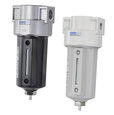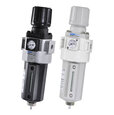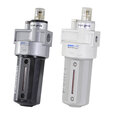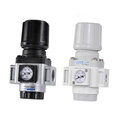How and When To Oil Pneumatic Tools
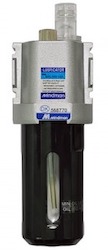
Figure 1: Air lubricator
Pneumatic tools require regular maintenance to increase their efficiency and durability. Oiling is one necessity to keep air tools in optimal condition. Air tools have different parts and mechanisms, requiring different oiling procedures. Moreover, the frequency of oiling your air tools depends on multiple factors. Manufacturers typically issue guidelines on how to oil their pneumatic tools. This article gives a complete guideline on oiling pneumatic tools.
Table of contents
- Oiling pneumatic tools
- Pneumatic tool oil types
- How often should an air/pneumatic tool be oiled?
- How to oil pneumatic tools
- FAQs
View our online selection of filters, regulators & lubricators!
Oiling pneumatic tools
Most pneumatic tools, or air tools, need regular lubrication for optimum performance. Regular oiling helps prevent freeze-ups and tool deterioration. Moisture in the air mixes with the oil inside the pneumatic tool, creating a complex watered-down lubricant. If the air tool doesn't receive proper lubrication, the mixture triggers premature wear and tear, grinding, and sometimes rusting.
Oiling removes any residual moisture that accumulates during use and prevents rust. Moreover, the oil creates a coating that prevents metal-on-metal contact and stops friction. This, in turn, allows smoother operation and extended air tool life.
Here are the benefits of oiling pneumatic tools:
- Prevent rust build-up
- Prevent moisture build-up
- Ensure free movement of parts
- Remove sludge and calcium deposits
- Ensure free movement of parts
- Remove build-up on components
- Create smooth starts and stops
- Prevent o-ring breakdown
Read our article on pneumatic tool oil for more information on the types and selection criteria for pneumatic oil.
Pneumatic tool oil types
Oils are created differently and for specific uses. For example, certain oils may degrade o-ring seals and other components of pneumatic tools. However, oils meant for air tools are mostly non-detergent or specially designed additives and anti-rust agents formulated to meet industry standards. Therefore, it's essential to use a type of oil that is specific to the pneumatic tool in use.
Pneumatic tool oil differs from other oil types. The oil has low viscosity; therefore, it's easily atomized and transported throughout the pneumatic tool by compressed air. Unlike petroleum-based oils, mineral-based or synthetic oils do not leave behind the sticky build-up on the components of the pneumatic tool. While mineral-based and synthetic oils are ideal for pneumatic tool lubrication, one might be more suitable depending on various factors.
Mineral-based air tool oil
Mineral-based air tool oil is the standard and most common oil for pneumatic tool lubrication. Unfortunately, it evaporates quickly; therefore, the user should lubricate the air tools more frequently. Moreover, mineral-based pneumatic tool oil is more reactive—it reacts with other materials and clumps up. Consequently, this type of oil will reduce the tool's durability.
Synthetic-based air tool oil
Synthetic-based air tool oil has a higher performance, reduces friction, and can extend the lifespan of a pneumatic tool by up to 50%. Unlike mineral oils, this type of oil doesn't gum up in the air tool. However, synthetic-based air tool oil is more expensive than mineral-based pneumatic tool oil.
How often should an air/pneumatic tool be oiled?
It is advised to oil pneumatic tools regularly to maintain their performance. There's no fixed frequency to oil pneumatic tools, meaning the user can lubricate the pneumatic tools daily, weekly, or even monthly. But the best way to do this is to consider the manufacturer's guidelines. A pneumatic tool always comes with maintenance instructions, including how often to oil the tool. Most manufacturers recommend oiling pneumatic tools at regular intervals, for instance, daily or weekly.
However, the frequency of using the tool may also influence how often to oil it. For instance, if you use your air tool more frequently, you may need to oil it daily or throughout the day to prevent damaging the tool's components.
Most air nailers and staplers need about 4-5 drops of pneumatic oil daily. Air sanders need about three drops of oil at the end of the day. Moreover, 2-3 drops of pneumatic oil applied daily will keep an air buffer in top shape.
How to oil pneumatic tools
The process of oiling air tools may vary depending on the tool type and its components.
How to oil a pneumatic impact wrench
An air impact wrench, or pneumatic impact wrench, is a tool that uses air to multiply a force and to easily remove tougher nuts and bolts. A pneumatic impact wrench has two parts that need regular lubrication: the motor and the impact mechanism. The two parts are separate, and therefore they should be oiled separately. A specific oil lubricator oils the motor added directly to the air inlet or FRL.
Here's how to manually oil the impact wrench motor:
- Add 10-15 drops of pneumatic oil to the air inlet.
- Run the impact wrench for a few seconds to distribute the oil through the motor
- If using an impact wrench for extended periods without a lubricator, re-apply the pneumatic tool oil after every few hours of use.
On the other hand, the impact mechanism is oiled in two ways depending on the tool's mechanism.
- Oil bath impact mechanism: If the pneumatic tool uses an oil bath impact mechanism, submerge the whole front part of the impact wrench in oil. The oil is always there, so the impact mechanism requires less maintenance. To change the oil in the oil bath impact mechanism, open the wrench carefully and drain the used oil. And when replacing the oil, use the oil recommended for the impact wrench system.
- Grease impact mechanism: Apply grease to the contact points between the anvil and the hammer. This helps prevent friction between the two points. Over time, the grease will move from the touchpoints to the outside of the hammer, creating more friction and heat. Therefore, it's important to oil the grease impact mechanism regularly. To oil the grease impact mechanism, open the tool carefully and add oil using your hands or brush. Focus on the contact points—the anvil and the hammer's inner area to reduce friction.
How to oil a pneumatic nail gun
A pneumatic or air nail gun is a tool powered by compressed air and used to shoot staples and nails into timber or masonry.
The components will experience unnecessary wear and potentially corrode if they are not oiled regularly. Follow these simple steps to oil a pneumatic nail gun.
- Remove all the nails in the gun: For the user’s safety, remove any nails left in the chamber, cartridge, or strip. This also makes oiling a pneumatic nail gun effortless.
- Hold it in an upright position: The easiest way to oil a pneumatic gun is when it's upright.
- Apply the oil: Use a pneumatic oil bottle to apply 3-5 drops of oil. A nail gun has three critical parts that need lubrication: the trigger, air fitting, and the feed system.
- Pull the trigger: Pull the trigger several times to spread the oil throughout the gun.
How to oil a pneumatic rivet gun
An air rivet gun can quickly malfunction and break if not oiled and maintained well. The components will wear out, and the gun won't function as required. Routine maintenance of an air rivet gun includes proper oiling and inspection of the air cylinder and jaw assembly.
An FRL unit, oiler, or fogger, can lubricate a pneumatic rivet gun. Alternatively, the user can lubricate the tool manually with pneumatic tool oil. Here's the procedure:
- Add 3-4 drops of pneumatic tool oil to the rivet gun's air inlet before connecting the air hose.
- Lubricate the air rivet gun daily if you use it over several days.
- If you use the air rivet gun throughout the day, lubricate after every 1-2 hours.
FAQs
Why should you oil pneumatic tools?
Oiling air tools helps prevent rust and moisture build-up. It also creates smooth starts and stops and ensures the free movement of parts.
Which Is the best oil for lubricating pneumatic tools?
Synthetic or mineral-based oils are ideal for lubricating air tools. Always follow the manufacturer’s guidelines before using the oil.
How often should a pneumatic tool be oiled?
It depends on the tool's mechanism and frequency of use. For instance, if you use your air tool several times throughout the day, you'll need to oil it every 2 hours.




